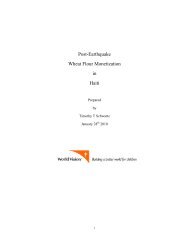Food Consumption Patterns Part 2
You also want an ePaper? Increase the reach of your titles
YUMPU automatically turns print PDFs into web optimized ePapers that Google loves.
70<br />
9. The Entrance of Imported Snack <strong>Food</strong><br />
Introduction<br />
<strong>Food</strong> preparation specialists have helped popular class Haitians adapt to deepening poverty while<br />
still allowing them to obtain high calories at low cost. In the process they invigorate the local<br />
economy and earn income to support themselves and their families. But alternative sources of<br />
prepared food have emerged over the last two decades that compete with the local food preparation<br />
economy. The earliest of these foods were sugar and malt based beverages (sodas, juices, and<br />
maltas), cheese cubes, condensed milk, precooked sardines, and corn flakes. More recent snack<br />
foods incled cookies, salted crackers, and cheese puffs. These foods not part of an integrated local<br />
adaptation to poverty but rather a global one. Most are prepared, not in impoverished Haiti and not<br />
with Haitian produce, but rather with low cost ingredients from industrial producers in other<br />
countries. Some of these countries are geographically near to Haiti, such as the Dominican<br />
Republic and Guatemala; others on the far side of the world, such as India and Pakistan. All are<br />
developing countries.<br />
There are problems with the current RUF (Read to Use <strong>Food</strong>s) sold in Haiti that should not be<br />
ignored. The foods are imported and sold on the streets, in open-air markets, and in stores, where<br />
they come into competition not only with local produce, but also with the cottage food preparation<br />
industry seen in the previous section and arguably lead consumers away from success in the quest<br />
for affordable and, if not nutritious, at least high caloric foods. The issue is not so much that<br />
Haitians are eating the low nutritional foods—such as extruded corn snacks like cheese puffs,<br />
made from degermed corn meal (meaning most of the nutrients are stripped away--but that they<br />
forego opportunities to spend limited resources on more nutritious fare. As seen in earlier sections,<br />
sometimes the problem is simply that higher quality foods are not available, as they have short<br />
shelf lives and do not ship well. But now that popular class Haitians have access to these lownutrition<br />
snack foods on nearly every street corner, they are being used as quick substitutes for<br />
more balanced, true meals and for the oil laden but often hi-protein street foods.<br />
That is not the worst of it. At least some of the earliest imports were high quality foods. Condensed<br />
milk sold in cans, powdered milk, and cheese cubes were three RUFs that offered popular class<br />
Haitians an affordable high protein food supplement. But high level entrepreneurs, almost entirely<br />
local individuals and corporate entities, have increasingly taken over the market with introduction<br />
of imitation brands concocted from low cost and low quality ingredients, most commonly palm oil<br />
and soy byproducts. The nutritional threat food substitutes and disingenuous advertising is a<br />
problem anywhere. But in a country like Haiti where close to 50% of the population is comprised<br />
of a nutritionally stressed and extremely poor people induced to spend scarce cash reserves on junk<br />
food the problem is especially acute and should be considered and issue of humanitarian concern<br />
for everyone, Haitian and otherwise. Indeed, given the flaunting of accepted international<br />
standards and the impoact on consumers, the international justice system should take special note.<br />
In the sections that follow we attempt to provide as complete a picture as possible of the<br />
complexities of the problem.
















